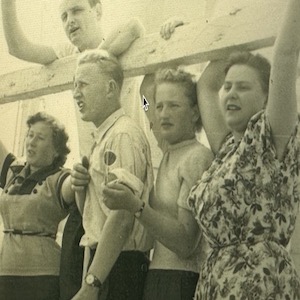Migration to New Worlds
Migration to New Worlds is a multi-archive collection that provides an in-depth look at the history of migration to the United States, Canada, New Zealand and Australia, mainly from 1800 to 1924. Thousands of unique primary documents are presented from 26 contributing archives, libraries, and museums, including the American Antiquarian Society, the British Library, the National Archives UK, and the New York Tenement Museum. Most of these collections deal with European emigration, with an emphasis on English, German, Irish, Italian, Jewish, Polish, Scandinavian, and Scottish experiences. Documentation of Chinese and Japanese migration to the United States is also included.
The homepage offers a simple search box at the top right of the screen and a main toolbar below that with links to the “introduction,” “documents,” “explore,” “galleries,” “oral histories,” "convict database," and "help." This is also where users will find options to perform an advanced query or visit popular searches. The core section is "documents," which allows users to explore all documents in the collection or view the documents through document type, library/archive, or themes. There is a broad array of documents, including diaries, manuscript correspondence, travel journals, and shipping logs. These sources provide first-hand accounts for research into emigration experiences and the hardship of settlement. These are supplemented by government papers, objects, emigration pamphlets, magazines and periodicals, newspapers, legal papers, and scrapbooks. The materials provide context to the history of migration, legislation, and living conditions during this period. While using those sources during the class, teachers may have students think about a series of questions: What were conditions like at ports of departure, and how did they change over time? What checks did emigrants undergo before embarkation? Why were shipping lines so important for the growth of British and Irish emigration? What dangers could an emigrant face during their voyage, and how did these evolve with technological advances in ocean travel?
Another important section is the "Visual Gallery," which provides access to various visual resources, including advertisements, illustrations and sketches, hand-drawn maps, ship plans, ephemera, photographs, postcards, posters, and watercolors. Another section is "oral histories," which includes the interviews from the Tenement Museum described the experiences of European immigrants living in New York tenement buildings during the early twentieth century. Other projects include interviews with war brides, political refugees, and displaced persons. Two independent oral history collections offer detailed insights into the daily life of Italian American and Finnish American families in the New York area during the early twentieth century.
Under the section "Explore," "The Essays" tab includes fifteen commissioned academic essays to give useful background context to the documents, photographs, and objects found in Migration to New Worlds. The tabs "Migrant Stories," "Biographies," and "Tenement Biographies, New York" introduce the stories of immigrants and their families and also include the stories of British immigration officials and the agents of colonization enterprises. "The Search Directories" tab provides a page that lists the people, ports and places, ships, and keywords occurring frequently in the documents to guide users in quickly finding resources. The "External links" provide the link to each institution and online database, allowing users to perform further research. The most interesting tab is "Interactive Research." The "Tenement Museum Apartments, New York" allows users to explore the two apartments in the Tenement Museum, New York – the Rogarshevsky family apartment and the Levine family apartment. Users can view the specific floor plan, the full-size object photographs, and the 360-degreepanorama of ‘Parlor’, ‘Kitchen’ or ‘Bedroom.’ Users can also explore related documents, oral histories, and tenement biographies by selecting from the slide bar. The "Star of India immigrant ship" shows users what the Star of India would have looked like. The "Migration Map" lists graphs and tables of the numbers of European and Asian people who immigrated to the United States, Canada, Australia, and New Zealand. The tool can also show numbers and percentages of immigrants throughout each year.
Migration is a complex, varied, and global experience that has impacted all Americans either directly or indirectly. The emphasis on the personal layer, which lies beneath the material object, highlights Migration to New Worlds' belief that seemingly simple or ordinary objects can be symbols of extraordinary experiences and have great emotional power. Migrants have frequently been excellent documenters of their own stories. Objects can speak through the voice of the people that owned, used, and made them. By documenting these personal stories, this collection helps to enrich the history of migration and help people gain significant insights into the broader narratives of migration. Overall, Migration to New Worlds' collections is an invaluable scholarly resource that allows us to hear voices from another time. All these hundreds of stories create interconnected, interwoven narratives that provide insights into who we are as a community, where we have come from, and who and what will shape us in the future.
